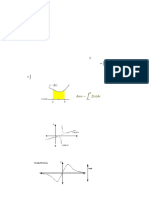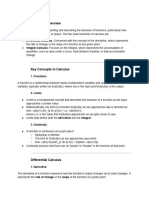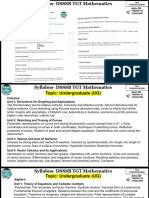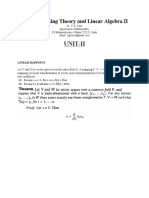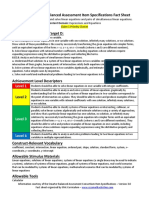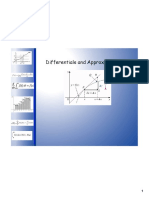AP Calculus AB Study Sheet
AP Calculus AB Study Sheet
Uploaded by
Kohji Ashitaka SugiokaCopyright:
Available Formats
AP Calculus AB Study Sheet
AP Calculus AB Study Sheet
Uploaded by
Kohji Ashitaka SugiokaOriginal Title
Copyright
Available Formats
Share this document
Did you find this document useful?
Is this content inappropriate?
Copyright:
Available Formats
AP Calculus AB Study Sheet
AP Calculus AB Study Sheet
Uploaded by
Kohji Ashitaka SugiokaCopyright:
Available Formats
Mar 13
AP Calculus AB Study Sheet
1 of 4
KEY DEFINITIONS
limit this is what distinguishes Calculus from other math. A limit of a function is the value that the dependent variable approaches as the independent variable approaches a given value. A limit has the general form lim x h f x This gives the value that the function is tending toward as x approaches h. derivative this describes the slope of the graph, or the rate of change of the function. The derivative may be dy d [ y] . Each of these examples given refers to "THE notated in many ways, including y ' , , and dx dx DERIVATIVE OF Y WITH RESPECT TO X." To use function notation, the derivative of f x is f ' x . The limit f x h f x definition of derivative is lim h0 h differential a special variable used in taking derivatives and solving differential equations. A differential equation is solved by integration. implicit differentiation useful when there are multiple variables in the expression. When the derivative is taken, simply multiply by the corresponding differential. integral this describes the area under the curve. The integral is the inverse of the derivative, and thus is also called the anti-derivative. Notation is one of two ways: f x dx or F x In the latter case, it cannot be assumed that F always means the anti-derivative of f. The above examples are indefinite integrals, meaning that they give a general solution. When evaluating a definite integral, the result is the area under the curve. Definite b f x from a to b. integrals have the form f x dx ; this example will yield the area under
critical numbers these are the values of the independent variable at which the first derivative is zero: f ' x =0 . They also occur where the first derivative is undefined, such as at a cusp or sharp corner (like absolute value). These numbers are useful when looking for changes in the trend of the graph: either increasing or decreasing. Critical numbers also indicate relative extrema, either relative maxima or relative minima. absolute extrema absolute maxima and minima must be found by using CRITICAL NUMBERS and the ENDPOINTS OF THE INTERVAL. Whichever value is furthest to the desired extreme is given as the absolute extrema. inflection inflection is the change of the concavity of the graph. A graph is either concave up or concave down (a horizontal line would have both or none) Points of inflection occur where the second derivative is zero. Evaluation of the second derivative at any value yields the concavity; f ' ' x 0 concave up ; f ' ' x 0 concave down mean value theorem (for derivatives) this theorem declares that there must be at least one point on a given interval for which the instantaneous slope (derivative) equals the average rate of change over that interval. The function must be continuous on the closed interval, and differentiable on the open interval. Symbolically, this is f b f a expressed f ' c = where a , b is the open interval. ba Rolle's theorem this is a simpler version, and an application of the mean value theorem. It adds the condition that, on the interval a , b , f a= f b . This means that the average slope is zero, and there must be a point c at which f ' c =0 position, velocity, and acceleration that's the order, a t=v ' t = s' ' t or s t= v t dt = [ a t dt ] dt
Mar 13
AP Calculus AB Study Sheet
2 of 4
DERIVATIVES
For all of the following, x is considered to be the independent variable, n is a real number, c is a nonzero real number, a is a positive integer, and u and v are differentiable functions. d d n [ f u]= f ' u u ' [ x ]=nxn1 Simple Power Rule: Chain Rule: dx dx d d u' d u' [cu ]=cu ' [log a u]= [arctan u ]= 1. 11. 21. dx dx ln a u dx 1u 2 d d u d u ' [uv ]=u' v ' [a ]= ln a a u u ' 2. 12. [arccot u ]= 22. dx dx dx 1u 2 d d d u' [uv ]=uv ' vu ' Product Rule 13. [sin u ]=cos u u' 3. 23. dx [arcsec u]= dx dx u u2 1 d d u vu 'uv ' d u ' [cos u ]=sin u u ' = 4. Quotient Rule 14. 2 dx dx v 24. dx [arccsc u]= v u u 21 d 2 d [tan u]=sec u u ' 15. [c ]=0 5. d x 1 dx [arcsin ]= 2 2 dx 25. dx a a x d d n [cot u]=csc 2 u u ' 16. [u ]=nu n1 u ' 6. d x 1 dx dx [arccos ]= 2 2 26. dx a a x d d [sec u]=sec u tan u u ' 17. [ x ]=1 7. dx d x a dx [arctan ]= 2 2 27. d dx a a x d u [csc u]= csc u cot u u ' 18. [u]= u' , u0 8. dx d x a dx u [arccot ]= 2 2 28. d u' d u' dx a a x [arcsin u ]= 19. [ln u]= 9. dx 1u 2 dx u d x a 29. dx [arcsec a ]= d u' d u u x x 2a 2 [arccos u ]= [e ]=e u ' 10. 20. 2 dx dx 1u d x a 30. dx [arccsc a ]= x x 2a 2
[]
Mar 13
AP Calculus AB Study Sheet
3 of 4
INTEGRALS
For all of the following, k, C, and n are real numbers; u is a differentiable function. 1. k f u du=k f u du 11. cot u du=lnsin uC 2. [ f u g u] du= f u du g u du 12. sec u du=lnsec utan uC 3. du=uC General rule 13. csc u du=lncsc ucot uC n1 2 u 14. sec u du=tan uC 4. u n du= C , n1 General rule 2 n1 15. csc u du=cot uC du 5. =lnuC 16. sec u tan u du=sec uC u u u 17. csc u cot u du=csc uC 6. e du=e C du u 1 u u 18. 2 2 =arcsin C a C 7. a du= a a u ln a du 1 u 8. sin u du=cos uC 19. 2 2 = arctan C a a u a 9. cos u du=sin uC u du 1 = arcsec C 20. 10. tan u du=lncos uC 2 2 a a u u a
Fundamental Theorem of Calculus this multi-part theorem is very important! b Part 1: a f x dx= F b F a that is to say, that once the anti-derivative of the function is found
(usually using the simple power rule for integrals), the integral on the closed interval [ a , b] is equal to the difference in the anti-derivatives at each endpoint. x d Part 2: a f t dt = f x or F ' x= f x This states that the derivative of the anti-derivative is dx the original function. Be careful applying this, though. The example given takes the integral over [ a , x ] , but if x is a differentiable function, you must use the chain rule eventually.
The Mean Value Theorem for Integrals if f is continuous on the closed interval [a,b] then there exists a b number c in the closed interval [a,b] such that a f x dx= f c ba This means that there exists a rectangle such that its area is equal to the area of the region under the curve. average value the mean height of a function on the open interval a , b is
b 1 a f u du ba
area between two curves the basic concept here is that the area between two curves is equal to the total area from the upper curve to the zero line, minus the area from the lower curve to the zero line. For all real numbers a and b as the endpoints of the interval, for an upper function f(x) and lower function g(x), the area between them is b b b a [ f x g x] dx=a f x dxa g x dx To use this formula, f(x) must be greater than g(x) over the entire interval. Likewise, everything could be done in terms of y: For all real numbers a and b as the endpoints of the interval, for an upper function f(y) and lower function g(y), the area between them is b b b a [ f y g y] dy=a f y dya g y dy To use this formula, f(x) must be greater than g(x) over the entire interval (This means f(x) is farther to the right!).
Mar 13
AP Calculus AB Study Sheet
4 of 4
VOLUMES OF SOLIDS OF REVOLUTION
Representative Rectangles Remember the Reimann sums that explained the integral concept? This is the same thing. When we say representative rectangles in solids of revolution, we mean a little strip of the region that will be revolved around the axis of revolution to become either a disk, washer, or shell. Axis of Revolution This is a line about which a two-dimensional region is revolved to become a threedimensional solid. The Disk Method This method may be used when representative rectangles are perpendicular to the axis of rotation, and when the region to be revolved is flush with the axis of revolution over the entire interval. The formula is based on the area formula for a circle, A= r 2 . Instead of a simple quantity r, we have an entire function represented as R(x).There are two versions of the formula, one dealing with horizontal axes of revolution b b and one with vertical. V = a [ R x ]2 dx or a [ R y]2 dy The Washer Method The washer method is identical to the Disk Method, except for one condition: the region to be revolved need not be flush with the axis of revolution; in fact, it might not touch it at all! The representative rectangles still need to be perpendicular to the axis of revolution. The formula is b b V =a [ R x]2 [ r x ]2 dx or a [ R y ]2 [r y ]2 dy R(x) must be greater than r(x) over the entire interval, and likewise for y. The Shell Method This one is different. The region need not be flush with the axis of revolution, and the representative rectangles must be parallel to the axis of revolution. The volume formula is an application of the circumference of a circle, C=2 r . In the shell method, p(x) is the distance of the rectangle from the axis of revolution, and h(x) is the height of the rectangle. When writing the integral, make sure that if everything is in terms of x, and there is a dx at the end, that the limits of integration are also x-values! Everything may be applied b b to functions in terms of y. V =2 a p x h x dx or 2 a p y h y dy Volumes of Known Cross-Sections This is a strange concept. Basically, you want to make a region pop out of the page by placing a certain shape on it. For example, take the region shown below. Place a vertical SQUARE on each x-value. The size of the square changes at each location, and is dependent on the vertical height of the region. This dependent value is known as the base. The base is used to calculate the area of the b pop-out for each x from a to b. Always use vertical rectangles. V =a A x dx You'll need some area formulas to do all of this right! (Notice that most have a b2 term) Cross-Section Area Formula Square Equilateral Triangle Isosceles Right Triangle (Hint: the right angle is opposite the base) Semi-circle Rectangle (of given height h)
A x =b 2
3 A x = b 2 4 1 A x = b2 4 1 A x = b2 8 A x =bh
You might also like
- Maths ProjectDocument26 pagesMaths Projectchaudhary.vansh2307100% (5)
- SS2 Further Maths 1ST Term E-NoteDocument57 pagesSS2 Further Maths 1ST Term E-NoteJesse100% (2)
- Multivariable Calculus Review SheetDocument2 pagesMultivariable Calculus Review SheetSteven Walker100% (1)
- Mathematics: Illustrations of Quadratic EquationsDocument16 pagesMathematics: Illustrations of Quadratic EquationsABIGAIL ROSACEÑANo ratings yet
- AP Calculus BC Study GuideDocument5 pagesAP Calculus BC Study GuideJohn MoonNo ratings yet
- AP Calculus BC Study GuideDocument16 pagesAP Calculus BC Study GuideBrimwoodboy100% (3)
- Programming and Slicing Optimization: GORDIAN: VLSI Placement by QuadraticDocument10 pagesProgramming and Slicing Optimization: GORDIAN: VLSI Placement by QuadraticPiyush PatelNo ratings yet
- Curvature: PrerequisitesDocument14 pagesCurvature: PrerequisitesmathplazaNo ratings yet
- Appendix A 2Document6 pagesAppendix A 2ErRajivAmieNo ratings yet
- AP Calculus AB - Ultimate Guide Notes - KnowtDocument29 pagesAP Calculus AB - Ultimate Guide Notes - Knowtcondyerhaze1No ratings yet
- AP Calculus Cheat SheetDocument2 pagesAP Calculus Cheat Sheet3d5w2dNo ratings yet
- Mcmain SolidsofrevolutionDocument15 pagesMcmain Solidsofrevolutionapi-280902734No ratings yet
- Curve Sketching Is Another Practical Application of Differential CalculusDocument11 pagesCurve Sketching Is Another Practical Application of Differential CalculusAmmad ImamNo ratings yet
- Differentiation & Maxima & MinimaDocument30 pagesDifferentiation & Maxima & Minimaakki2511No ratings yet
- 12 4 CurvatureDocument7 pages12 4 CurvatureDaniel SolhNo ratings yet
- Algebra Integrals and IntegrationDocument4 pagesAlgebra Integrals and IntegrationBharath KumarNo ratings yet
- Calc 111 Module 7 WK 13 14Document9 pagesCalc 111 Module 7 WK 13 14colby kodyNo ratings yet
- Calculus Vocabulary Alphabetical ListingDocument7 pagesCalculus Vocabulary Alphabetical Listingstar.nguyenquynhanh.0101No ratings yet
- Pre Calculus To Calculus Formulas)Document66 pagesPre Calculus To Calculus Formulas)Anthony Cruz100% (3)
- Conservative PDFDocument18 pagesConservative PDFAbha SrivastavaNo ratings yet
- Week 2.1Document5 pagesWeek 2.1peximan397No ratings yet
- Mathematics PROJDocument38 pagesMathematics PROJRaj SinghNo ratings yet
- Integrals MATH 101Document5 pagesIntegrals MATH 101Cris JacksonNo ratings yet
- Unit 1 Notes PDFDocument18 pagesUnit 1 Notes PDFCharles GribbenNo ratings yet
- Chain RuleDocument23 pagesChain RuleRaZa UmarNo ratings yet
- Differential CalculusDocument6 pagesDifferential CalculusGift NathanNo ratings yet
- Two-Dimensional Airfoils: 1 DefinitionsDocument5 pagesTwo-Dimensional Airfoils: 1 DefinitionsKing MassNo ratings yet
- Mathematics-Ii: Prepared By: Ms. K. Rama Jyothi,: Mr. G Nagendra KumarDocument118 pagesMathematics-Ii: Prepared By: Ms. K. Rama Jyothi,: Mr. G Nagendra KumarNithya SridharNo ratings yet
- Line Integral Information SheetDocument7 pagesLine Integral Information SheetRobert KoernerNo ratings yet
- Some Useful Integrals of Exponential Functions: Michael FowlerDocument6 pagesSome Useful Integrals of Exponential Functions: Michael FowlerSunny HungNo ratings yet
- ETH Zurich - Mechanics of Building Materials, Elastic TheoryDocument64 pagesETH Zurich - Mechanics of Building Materials, Elastic TheoryYan Naung KoNo ratings yet
- Calculus of Variation and Image Processing: Scalar ProductDocument9 pagesCalculus of Variation and Image Processing: Scalar ProductAditya TatuNo ratings yet
- Chap-7 Differentiation Revesion Note1Document21 pagesChap-7 Differentiation Revesion Note1masroorazmi21No ratings yet
- Calculus 1 Topic 1Document9 pagesCalculus 1 Topic 1hallel jhon butacNo ratings yet
- Aaaaaaa As ADocument17 pagesAaaaaaa As ANuwan SenevirathneNo ratings yet
- Chapter 4 - Applications of DerivativesDocument132 pagesChapter 4 - Applications of DerivativesPhúc HồngNo ratings yet
- Project in Calculus IiDocument14 pagesProject in Calculus IiBunny DummyNo ratings yet
- Electricity and Magnetism NotesDocument170 pagesElectricity and Magnetism NotesUmit UtkuNo ratings yet
- Applications of Derivatives: Complete Study Guide & Notes OnDocument5 pagesApplications of Derivatives: Complete Study Guide & Notes OnJuhi NeogiNo ratings yet
- Calculus - OverviewDocument4 pagesCalculus - Overviewa01649347No ratings yet
- Differential Calculus: Engr. Denver MagtibayDocument74 pagesDifferential Calculus: Engr. Denver MagtibayViene BagsitNo ratings yet
- Differential CalculusDocument21 pagesDifferential CalculusRay RoseNo ratings yet
- Microproject PPT (MATHS)Document26 pagesMicroproject PPT (MATHS)BURHANUDDIN RATLAMWALANo ratings yet
- Geometry: Steven SkienaDocument22 pagesGeometry: Steven SkienapropatrioNo ratings yet
- Variables or Real Multivariate Function Is A Function With More Than One Argument, With AllDocument8 pagesVariables or Real Multivariate Function Is A Function With More Than One Argument, With AllMhalyn Üü NapuliNo ratings yet
- Geom NotesDocument10 pagesGeom NotesJ Luis MlsNo ratings yet
- Viscous Fluid FlowDocument48 pagesViscous Fluid FlowTrym Erik Nielsen100% (1)
- PHYS2050 2010 2 Curl StuffDocument11 pagesPHYS2050 2010 2 Curl StuffEkky CecilNo ratings yet
- Solids of Revolution Essay 1Document15 pagesSolids of Revolution Essay 1api-397091166No ratings yet
- Anna's AssignmentDocument16 pagesAnna's Assignmenttumaini murrayNo ratings yet
- Naveen MathDocument14 pagesNaveen MathMohammad AlyNo ratings yet
- Derivatives 1Document25 pagesDerivatives 1Krrje INo ratings yet
- Maths PresentationDocument17 pagesMaths PresentationlshskhemaniNo ratings yet
- Zheng, Siqi CloverDocument14 pagesZheng, Siqi Clover027 Naveen Kumar VNo ratings yet
- Ejercicios Gregory Capitulo 14Document5 pagesEjercicios Gregory Capitulo 14Gabriel BonomiNo ratings yet
- BITSAT 2023 Paper Memory BasedDocument19 pagesBITSAT 2023 Paper Memory Basedkrishbhatia1503No ratings yet
- Maletski Calculus Paper 1Document12 pagesMaletski Calculus Paper 1api-280860495No ratings yet
- Math AA - Exploring The Method of Calculating The Surface Area of Solid of Revolution...Document22 pagesMath AA - Exploring The Method of Calculating The Surface Area of Solid of Revolution...VALENTINA GONZALEZNo ratings yet
- HSC Maths Ext1 CH2Document54 pagesHSC Maths Ext1 CH2moustafasadek11No ratings yet
- WKB ApproximationDocument14 pagesWKB Approximationamitsk144No ratings yet
- A-level Maths Revision: Cheeky Revision ShortcutsFrom EverandA-level Maths Revision: Cheeky Revision ShortcutsRating: 3.5 out of 5 stars3.5/5 (8)
- DSSSB TGT Maths Detailed Syllabus 2024 - 36004918 - 2024 - 07 - 01 - 21 - 48Document19 pagesDSSSB TGT Maths Detailed Syllabus 2024 - 36004918 - 2024 - 07 - 01 - 21 - 48Neha SinghNo ratings yet
- Chapter 6 - Stress and Strain - A4Document15 pagesChapter 6 - Stress and Strain - A4steven_gog0% (1)
- Perfect Square PDFDocument14 pagesPerfect Square PDFPebamdaso DasoNo ratings yet
- Page 1 To 4 Chapter 6 Inequalities Form 4Document4 pagesPage 1 To 4 Chapter 6 Inequalities Form 4Chicken LordNo ratings yet
- Unit-Ii: Core T14: Ring Theory and Linear Algebra IIDocument28 pagesUnit-Ii: Core T14: Ring Theory and Linear Algebra IITAPAS KUMAR JANA0% (1)
- Lecture 8: Bayesian Estimation of Parameters in State Space ModelsDocument33 pagesLecture 8: Bayesian Estimation of Parameters in State Space ModelsTrinh VtnNo ratings yet
- Problem 1. Laplace, Wald or Pessimistic, Optimistic, Hurwicz and Savage Criteria (Profit Matrix)Document30 pagesProblem 1. Laplace, Wald or Pessimistic, Optimistic, Hurwicz and Savage Criteria (Profit Matrix)vanessa sierra sanchezNo ratings yet
- Week 4Document29 pagesWeek 4suren dranNo ratings yet
- SbacDocument1 pageSbacapi-236759101No ratings yet
- Calculus Chapter 4 NotesDocument20 pagesCalculus Chapter 4 Notesian jheferNo ratings yet
- Fractional ProgrammingDocument53 pagesFractional Programmingjc224No ratings yet
- Graphs of Circular FunctionsDocument32 pagesGraphs of Circular FunctionsClemence Marie FuentesNo ratings yet
- Comparative Analysis of Methods For Computing and Electric FieldsDocument8 pagesComparative Analysis of Methods For Computing and Electric FieldsAnbu ArasanNo ratings yet
- Chapter 5: Relations, Functions, and Matrices: Tannaz R.Damavandi Cal Poly PomonaDocument52 pagesChapter 5: Relations, Functions, and Matrices: Tannaz R.Damavandi Cal Poly PomonaCL100% (1)
- Ch10 Applications of DifferentiationDocument61 pagesCh10 Applications of DifferentiationAyy ShanaNo ratings yet
- Operations On Fractions-Lesson 1Document18 pagesOperations On Fractions-Lesson 1Mye BeltranNo ratings yet
- Ass Dca2101Document10 pagesAss Dca2101tera baapNo ratings yet
- 15 5PostNotes PDFDocument6 pages15 5PostNotes PDFnair.aalamNo ratings yet
- MATHEMATICS Mind MapDocument13 pagesMATHEMATICS Mind MapSHANKARNo ratings yet
- Quadratic Equation: Ax BXCDocument9 pagesQuadratic Equation: Ax BXCMalaysiaBoleh98% (56)
- Andhra Pradesh S.S.C - 10 Class Board Examination - Important Questions - MATHEMATICSDocument13 pagesAndhra Pradesh S.S.C - 10 Class Board Examination - Important Questions - MATHEMATICSAnower Hossain100% (1)
- Trigonometric LimitsDocument5 pagesTrigonometric LimitsCaren NebresNo ratings yet
- Y7 Autumn Block 1 ANSDocument9 pagesY7 Autumn Block 1 ANSChrystal GraceNo ratings yet
- Algebra MediumDocument117 pagesAlgebra MediumSigma DaniNo ratings yet
- Cantor TheoremDocument4 pagesCantor TheoremAnup SaravanNo ratings yet
- Partial Differential Equation SolutionDocument3 pagesPartial Differential Equation SolutionBunkun15100% (1)
- Transforming Functions (H) QPDocument9 pagesTransforming Functions (H) QPtobieolle2No ratings yet

















